
Many types of traps can be used to monitor or control insect pests. Traps to capture insects vary greatly, depending on the target, location, and purpose. Traps may be inexpensive and disposable, or more complex. This 12-page fact sheet describes several traps for common pests in the home, garden, and landscape that can be made using common household materials or that are readily available in stores. Written by Steven Arthurs and Adrian Hunsberger and published by the Entomology and Nematology Department.
http://edis.ifas.ufl.edu/in1103
Tag: Steven P. Arthurs
Vespiform Thrips Franklinothrips vespiformis Crawford (Insecta: Thysanoptera: Aeolothripidae)
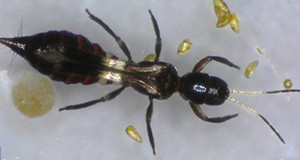
Franklinothrips vespiformis Crawford is a predatory thrips with a pantropical distribution. The distinctive red, humped-back larvae and fast-moving ant-like adults are predaceous on small arthropods. In addition to being easily mistaken for an ant, this beneficial thrips is unusual in that it constructs a silken cocoon within which it pupates. Males of this species are rare. This species is sold for use as a biological control agent in botanical gardens, zoos, interior landscapes, research greenhouses, nurseries with ornamental plants as well as outdoors in subtropical regions. This 4-page fact sheet was written by Runqian Mao, Yingfang Xiao, and Steven P. Arthurs, and published by the UF Department of Entomology and Nematology, March 2015. (Photo credit: Runqian Mao, UF/IFAS)
http://edis.ifas.ufl.edu/in1083
Emphasizing the Science, Technology, Engineering, and Math (STEM) in Agricultural Extension
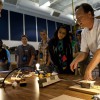 STEM is an acronym for science, technology, engineering, and math. In Extension, our purpose is to share the knowledge or products created through Ag-STEM research and design by universities and government agencies. Finding effective solutions to agricultural issues, especially in urban areas, increasingly involves working with clientele to solve problems jointly. Therefore, emphasizing the connections of STEM to agricultural problems through Ag-Extension programming can help our public audiences comprehend the problem-solving system underlying the content. The goal is to provide public audiences with self-confidence and skills in STEM, preparing them to be more engaged in the problem-solving process for the challenges ahead. This 5-page fact sheet was written by Kathryn A. Stofer, Laura A. Warner, and Steven Arthurs, and published by the UF Department of Agricultural Education and Communication, October 2014. (UF/IFAS photo by Tyler Jones.)
STEM is an acronym for science, technology, engineering, and math. In Extension, our purpose is to share the knowledge or products created through Ag-STEM research and design by universities and government agencies. Finding effective solutions to agricultural issues, especially in urban areas, increasingly involves working with clientele to solve problems jointly. Therefore, emphasizing the connections of STEM to agricultural problems through Ag-Extension programming can help our public audiences comprehend the problem-solving system underlying the content. The goal is to provide public audiences with self-confidence and skills in STEM, preparing them to be more engaged in the problem-solving process for the challenges ahead. This 5-page fact sheet was written by Kathryn A. Stofer, Laura A. Warner, and Steven Arthurs, and published by the UF Department of Agricultural Education and Communication, October 2014. (UF/IFAS photo by Tyler Jones.)
http://edis.ifas.ufl.edu/wc184
Convergent Lady Beetle Hippodamia convergens Guérin-Méneville (Insecta: Coleoptera: Coccinellidae)
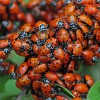 The convergent lady beetle, Hippodamia convergens Guérin-Méneville, is among the most common lady beetle species throughout North America and is an important natural enemy of aphids, scales, thrips, and other soft-bodied insects. It will also feed on pollen and nectar from flowers when prey is scarce. This species can be found in habitats ranging from grasslands, forests, agricultural fields, gardens, and natural parks. It is one of the few natural enemies that are currently wild-collected from mass aggregations for distribution to the pest control industry. This 5-page fact sheet was written by Luis F. Aristizábal and Steven P. Arthurs, and published by the UF Department of Entomology and Nematology, June 2014.
The convergent lady beetle, Hippodamia convergens Guérin-Méneville, is among the most common lady beetle species throughout North America and is an important natural enemy of aphids, scales, thrips, and other soft-bodied insects. It will also feed on pollen and nectar from flowers when prey is scarce. This species can be found in habitats ranging from grasslands, forests, agricultural fields, gardens, and natural parks. It is one of the few natural enemies that are currently wild-collected from mass aggregations for distribution to the pest control industry. This 5-page fact sheet was written by Luis F. Aristizábal and Steven P. Arthurs, and published by the UF Department of Entomology and Nematology, June 2014.
http://edis.ifas.ufl.edu/in1037
Swirski mite (suggested common name) Amblyseius swirskii Athias-Henriot (Arachnida: Mesostigmata: Phytoseiidae)
 Amblyseius is a beneficial predatory mite endemic to the Eastern Mediterranean region. This species is considered a generalist predator, and readily consumes small soft-bodied pest species as well as pollen or plant exudates. Amblyseius swirskii has attracted substantial interest as a biological control agent of mites, thrips and whiteflies in greenhouse and nursery crops and is currently reared and sold commercially in Europe and North America for this purpose. This 5-page fact sheet was written by Mahmut Dogramaci, Garima Kakkar, Vivek Kumar, Jianjun Chen, and Steven Arthurs, and published by the UF Department of Entomology and Nematology, June 2013.
Amblyseius is a beneficial predatory mite endemic to the Eastern Mediterranean region. This species is considered a generalist predator, and readily consumes small soft-bodied pest species as well as pollen or plant exudates. Amblyseius swirskii has attracted substantial interest as a biological control agent of mites, thrips and whiteflies in greenhouse and nursery crops and is currently reared and sold commercially in Europe and North America for this purpose. This 5-page fact sheet was written by Mahmut Dogramaci, Garima Kakkar, Vivek Kumar, Jianjun Chen, and Steven Arthurs, and published by the UF Department of Entomology and Nematology, June 2013.
http://edis.ifas.ufl.edu/in1001
Bagworm, Thyridopteryx ephemeraeformis Haworth (Insecta: Lepidoptera: Psychidae) (EENY548/IN981)
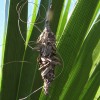 North American bagworm can feed on over 50 families of deciduous and evergreen trees and shrubs. Severe infestations can damage the aesthetics and health of host plants, especially juniper and arborvitae species. Many of the preferred host plants do not grow well below the USDA hardiness zone 8A, but due to its wide host range, high female fecundity, and method of dispersal, bagworm can still be problematic in the Florida landscape. This 5-page fact sheet was written by Brooke L. Moffis and Steven P. Arthurs, and published by the UF Department of Entomology and Nematology, March 2013.
North American bagworm can feed on over 50 families of deciduous and evergreen trees and shrubs. Severe infestations can damage the aesthetics and health of host plants, especially juniper and arborvitae species. Many of the preferred host plants do not grow well below the USDA hardiness zone 8A, but due to its wide host range, high female fecundity, and method of dispersal, bagworm can still be problematic in the Florida landscape. This 5-page fact sheet was written by Brooke L. Moffis and Steven P. Arthurs, and published by the UF Department of Entomology and Nematology, March 2013.
http://edis.ifas.ufl.edu/in981
Tropical sod webworm Herpetogramma phaeopteralis Guenee (Insecta: Lepidoptera: Crambidae) (EENY541/IN968)
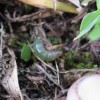 Tropical sod webworm larvae are destructive pests of warm season turfgrasses in the southeastern U.S., especially on newly established sod, lawns, athletic fields, and golf courses. Larval feeding damage reduces turfgrass aesthetics, vigor, photosynthesis and density. The first sign of damage is often caused by differences in grass height in areas where larvae are feeding. This 5-page fact sheet was written by Nastaran Tofangsazie, Steven P. Arthurs, and Ronald Cherry, and published by the UF Department of Entomology and Nematology, November 2012.
Tropical sod webworm larvae are destructive pests of warm season turfgrasses in the southeastern U.S., especially on newly established sod, lawns, athletic fields, and golf courses. Larval feeding damage reduces turfgrass aesthetics, vigor, photosynthesis and density. The first sign of damage is often caused by differences in grass height in areas where larvae are feeding. This 5-page fact sheet was written by Nastaran Tofangsazie, Steven P. Arthurs, and Ronald Cherry, and published by the UF Department of Entomology and Nematology, November 2012.
http://edis.ifas.ufl.edu/in968
Entomopathogenic Nematodes (Nematoda: Rhabditida: families Steinernematidae and Heterorhabditidae) (EENY530/IN944)
 Entomopathogenic nematodes are soft bodied, non-segmented roundworms that are obligate or sometimes facultative parasites of insects. They occur naturally in soil environments and locate their host in response to carbon dioxide, vibration, and other chemical cues. They fit nicely into integrated pest management programs because they are nontoxic to humans, specific to their target pests, and can be applied with standard pesticide equipment. This 4-page fact sheet was written by Nastaran Tofangsazie, Steven P. Arthurs, and Robin M. Giblin-Davis, and published by the UF Department of Entomology and Nematology, August 2012.
Entomopathogenic nematodes are soft bodied, non-segmented roundworms that are obligate or sometimes facultative parasites of insects. They occur naturally in soil environments and locate their host in response to carbon dioxide, vibration, and other chemical cues. They fit nicely into integrated pest management programs because they are nontoxic to humans, specific to their target pests, and can be applied with standard pesticide equipment. This 4-page fact sheet was written by Nastaran Tofangsazie, Steven P. Arthurs, and Robin M. Giblin-Davis, and published by the UF Department of Entomology and Nematology, August 2012.
http://edis.ifas.ufl.edu/in944